Circuit-Zone.com - Electronic Projects
Posted on Friday, June 7, 2024 • Category: FM Radio / Receivers
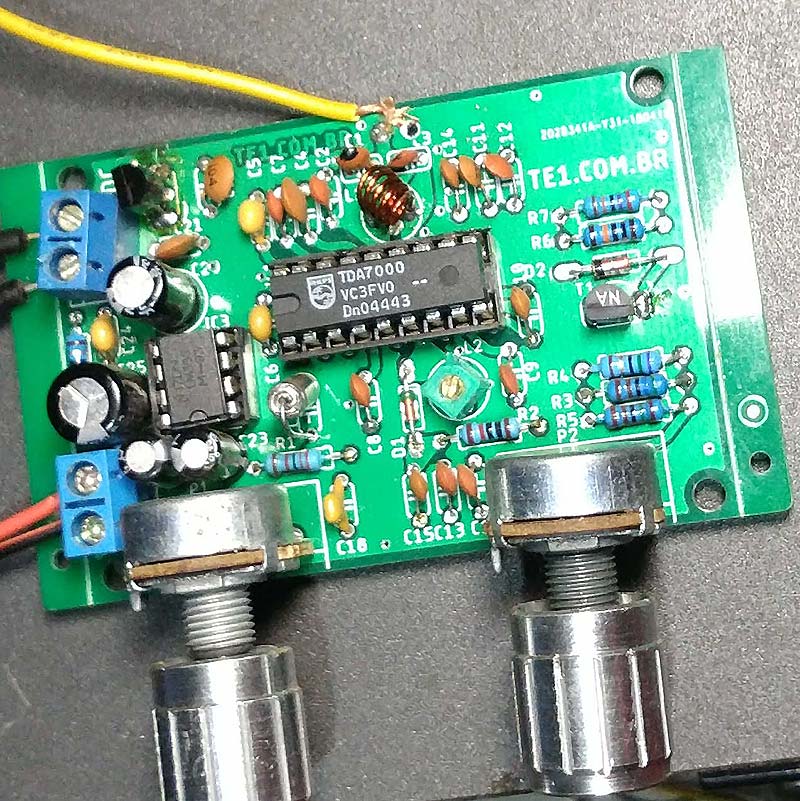
Simple circuit and easy to assemble DIY TDA7000 FM radio receiver with LM386 amplifier chip. Assembling an FM radio is always something interesting to the electronics enthusiast. TDA7000 which integrates a mono FM radio all the way from the aerial input to the audio output. Outside of the TDA7000 IC there is only one tunable LC circuit for the local oscillator, a few inexpensive ceramic capacitors and one resistor. The TDA7000 dramatically reduces assembly and post production alignment costs because only the oscillator circuit needs adjustment during manufacture to set the limits of the tuned frequency band. The complete FM radio can be made small enough to fit inside a calculator, cigarette lighter, key-ring fob or even a slim watch. The TDA7000 can also be used as receiver in equipment such as cordless telephones, CB radios, radio-controlled models, paging systems, the sound channel of a TV set or other FM demodulating systems.
Posted on Tuesday, February 1, 2022 • Category: FM Radio / Receivers
 This is perhaps one of the simplest and smallest FM receivers for receiving local FM stations. It's simple design makes it ideal for a pocket sized FM receiver. The audio output of the receiver is amplified through LM386 amplifier chip that can drive a small speaker or headphones. The circuit is powered by three AAA or AA battery cells. FM receiver section uses two RF transistors for converting frequency modulated signals to audio. L1 coil and variable capacitor form a tuned tank circuit that is used for tuning to any available FM stations.
Posted on Friday, December 24, 2021 • Category: FM Radio / Receivers
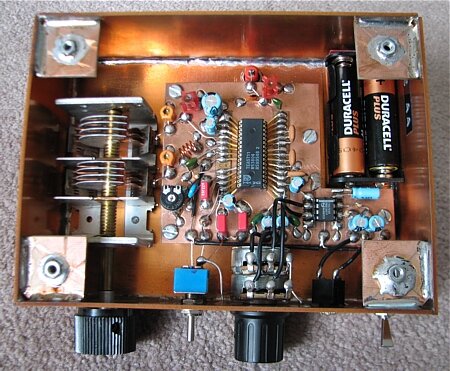 High sensitivity TEA5711 receiver allows the reception of distant stations from over 150 miles (240 km) away. Good selectivity is obtained with narrow bandwidth ceramic filters. AFC automatic frequency control locks on stations for drift-free reception. Stereo separation which depends on signal strength is very apparent on strong signals. And with high quality headphones, the sound is rich with deep base and high treble, for hours of enjoyable stereo music.
Posted on Friday, October 9, 2015 • Category: FM Radio / Receivers
 This is one of my favorite radio builds just because of how simple it is and how well it is able to pick up a lot of FM radio stations. I have browsed the world in search of a one transistor FM receiver. I have seen a couple but they were always attached to some sort of added device, such as another IC or another transistor for amplification in the receiver itself. Through my continued quest of searching for that too good to be true one transistor, I happened to run across a super-regenerative receiver, by Charles Kitchin, famous for his vast knowledge of regenerative designs. I printed out the schematic and made it. It turned out extremely well.
Posted on Tuesday, August 25, 2015 • Category: FM Radio / Receivers
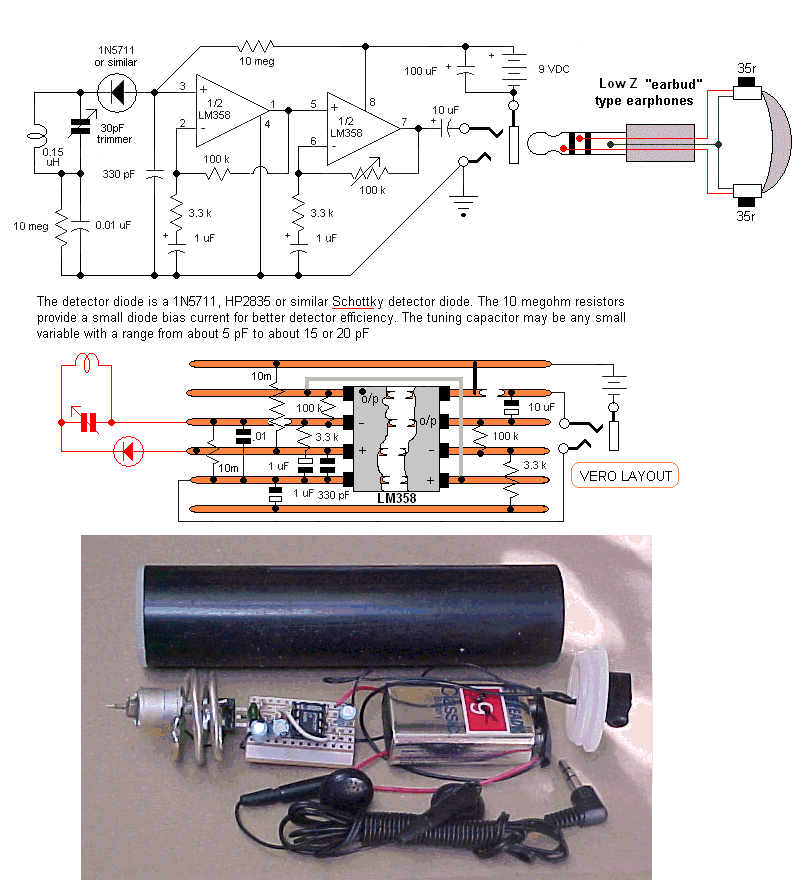 This passive airband receiver is basically an amplified "crystal radio" designed to receive nearby aircraft transmissions on 121 - 133 MHz frequency. Useful for listening to the pilot transmissions. The input tuned cct 'L' is a 2 turn loop, with 30mm diameter measured at 0.15uH on my LC Meter which intercepts RF directly as opposed to an LC cct fed with external aerial. Tuning capacitor is a 30pF Philips Beehive trimmer, with a short length of plastic tube glued - as a tuning shaft. Capacitance runs from 28 to 7pF; which by formula gives a frequency range of 77 - 155MHz. Detector uses a biased 1N5711 (or similar) schottky diode with lowest forward-biassed voltage drop. The two 10M resistors bias the detector diode and the op-amp input near mid-rail for better detector efficiency. LM358 dual op-amp draws less than 1 ma so the battery drain is minimal. Insertion of earphones plug completes supply circuit and acts as an on/off switch. 9V battery fits neatly inside a 30mm x 130mm long PVC tube.
Posted on Thursday, September 26, 2013 • Category: FM Radio / Receivers
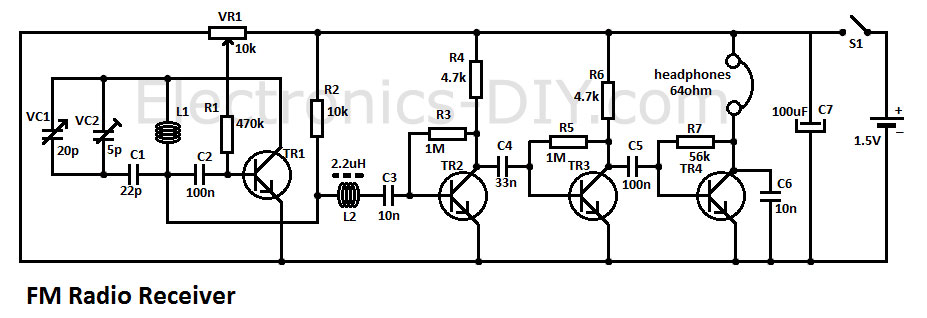 This FM radio receiver circuit is very simple to build and is powered by just a single 1.5V battery cell. Receiver consists of a regenerative rf stage, TR1, followed by a two of three-stage audio amplifier, TR2 to TR4. In some areas 3 stages of audio amplification may not be necessary, in which case TR3 and its associated components can be omitted and the free end of capacitor C5 connected to the collector of TR2.
The critical part of the fm radio receiver is the first stage, TR1/VC1, where the wirings must be kept as short as possible. Coil L1 is formed by winding 8 turns of 1mm (20 swg) enamelled copper wire on a 6 mm diameter former, which is then removed. After that L1 should be stretched carefully and evenly to a length of about 13mm.
Posted on Wednesday, May 15, 2013 • Category: FM Radio / Receivers
 Here's a portable FM broadcast radio receiver for reception of FM broadcast band based around FET transistor. The topology is a classic grounded-gate FET VHF Hartley oscillator. The drain resonator inductance is centre-tapped with feedback to the source through a small capacitance. By tapping down towards the cold-end of the coil the feedback isn't as critical as your usual source-drain capacitor feedback and it tends to be far less difficult to get to work across a broad range of frequencies. The RFC to an RC source circuit to implement self-quenching is very traditional for super-regenerative detectors. The quench gets frequency-modulated somewhat by the drain current, so it varies with signal strength and the recovered modulation, this is typical for self-quenched circuits.
Posted on Thursday, August 4, 2011 • Category: FM Radio / Receivers
 FM Radio Receiver IC TDA 7012T is very simple, but Radio This FM receiver has good sensitivity and selectivity. Single Chip TDA 7012T FM Receiver is to build an FM receiver requires a few additional components.
Feature contained in FM receiver IC TDA 7012T is quite tempting to an FM receiver. Among features an FM receiver TDA 7012T is a low-voltage applications micro affability arrangement (MTS), Frequency Locked Loop (PLL) to 76 KHz range and selectivity of FM receiver with RC Filter. In an article by FM Radio Receiver IC TDA 7012T can be seen in the FM receiver circuit which can be made.
Posted on Monday, July 25, 2011 • Category: FM Radio / Receivers
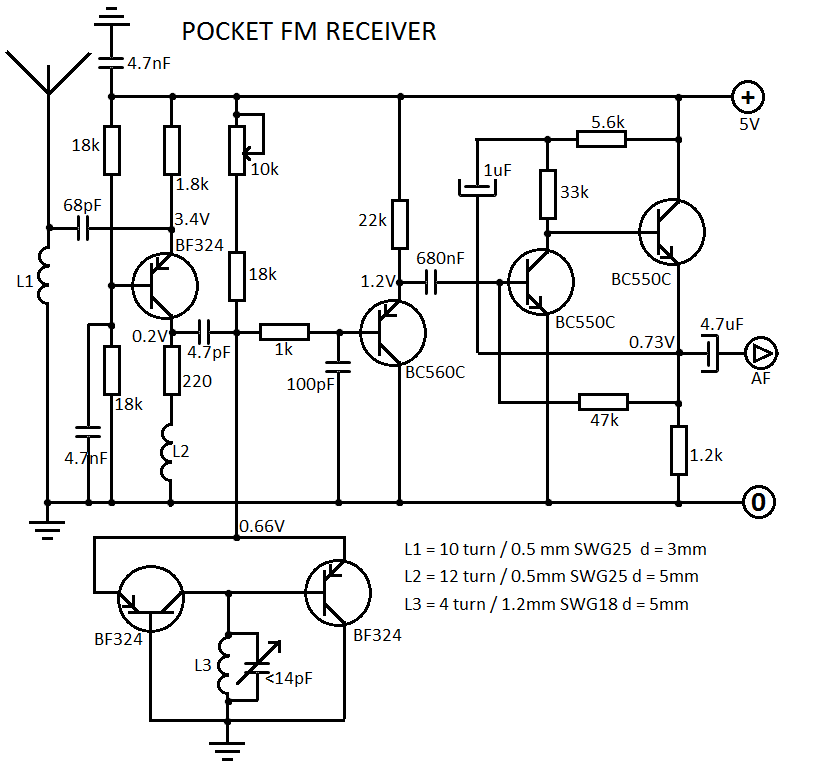 This is the most simple fm radio receiver with good performances that works great even if the sensitivity is not too high. The working principle of this fm receiver may seem a little unusual. It is made of an oscillator (T2 and T3) that is synchronized with the received frequency of T1. This transistor works as a broadband preamplifier in VHF range.
Posted on Friday, July 22, 2011 • Category: FM Radio / Receivers
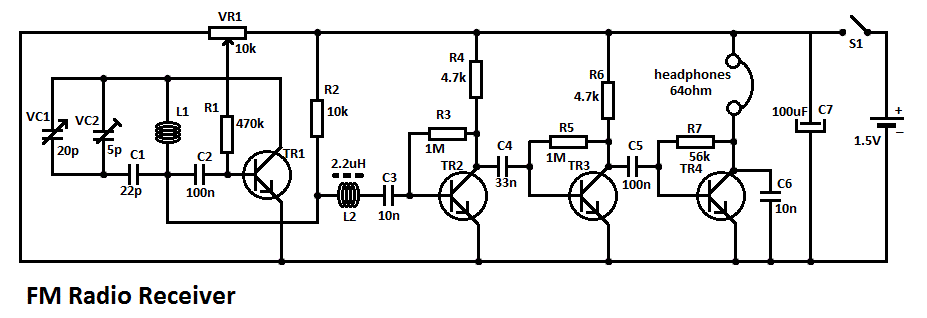 This simple fm radio receiver circuit consists of a regenerative rf stage, TR1, followed by a two of three-stage audio amplifier, TR2 to TR4. In some areas 3 stages of audio amplification may not be necessary, in which case TR3 and its associated components can be omitted and the free end of capacitor C5 connected to the collector of TR2.
Posted on Monday, July 18, 2011 • Category: FM Radio / Receivers
 This radio works with solar batteries that provide voltages between 0.5 and 2V. Microphones should be magnetic, high impedance (2k or more). The coil is wrapped around a ferrite rod 1 cm in diameter with 28AWG wire.
Posted on Tuesday, May 17, 2011 • Category: FM Radio / Receivers
 This tiny receiver is not much bigger than an AA cell. It is powered off two LR44 button cells, which are expensive and I assume wouldn't last terribly long. I'll be on the lookout for LR44's at the markets and $2 shops now that I've got this radio! As with all these sorts of radios, the headphone lead functions as the aerial. Supplied with this receiver were a pair of those awful "in-the-ear" type of miniature type earphones. Apart from the appalling sound quality, they are insensitive, unhygenic and dirty, fragile, and do not block out external sounds. So, I use the normal kind of headphones instead.
The enclosure is all clipped together, and once I'd opened it, sure enough, a TDA7088T was visible.
The audio amp appears to be one transistor; ie. single ended class A. I don't know what current it's drawing so I can't say whether it's consuming much more battery current than a class B amp would. In any case I would prefer AAA cells rather than the LR44's.
Posted on Tuesday, May 17, 2011 • Category: FM Radio / Receivers
 This project is a FM Radio based on TDA7000 and LM386 integrated circuits. What is unusual about TDA7000 IC is how it operates. It is a proper FM superhet receiver, with the usual local oscillator, mixer, IF amplifier, limiter, and phase detector. The difference is that there's only one tuned circuit; the local oscillator. Like the Pulse Counting Receiver, the TDA7000 relies on a low IF so that ordinary Op Amp circuitry can take care of the gain and bandpass characteristics. Only 70Kc/s is used with the TDA7000. Now, you might remember that the deviation of a broadcast FM signal is +/- 75Kc/s. A fully modulated signal would therefore sound rather distorted. So, how can this IC work?
It's quite simple in that there is what Philips call a Frequency Locked Loop. Basically, the local oscillator is shifted in response to detector output so that the bandwidth of the mixer output is never more than +/- 15Kc/s. It is actually compressing the frequency range of the modulated signal.
The muting or squelch feature is novel to say the least. Although it performs as any other muting circuit does, the TDA7000 provides an artificial noise generator so that the receiver still sounds alive while tuned off station. If you don't need that feature, just remove the .022uF condenser at pin 3. Not all Philips data sheets show it, but connecting a 10K resistor from the supply to pin 1 will disable the squelch.
Posted on Saturday, February 5, 2011 • Category: FM Radio / Receivers
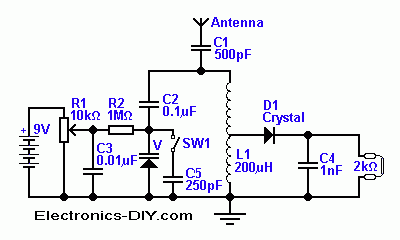 Traditionally, in a crystal detector radio tuned circuits, a mechanical type variable capacitor is used. For those of you who would like to eliminate this mechanical component, here is a modern version of the classic detector set. This radio, as shown on Figure 1, uses a varactor diode instead of the usual mechanical rotary device. The varactor is also known as a variable capacitance or a varicap diode. It provides an electrically controllable capacitance, which can be used in many different circuits. Varactors are small and inexpensive, which makes their use advantageous in many applications. Its disadvantages are a lower Q (quality), nonlinearity, lower voltage rating and a more limited capacitance range. A tuned circuit with a higher Q has a narrow pass-band that makes it better able to pick out a station of many equally strong. A lower Q tuned circuit has a wider pass band. It allows more neighbor stations through and makes listening to either radio stations frustrating. Frequency change with a varactor diode equipped tuned circuit is as simple as a voltage change.
Posted on Tuesday, October 5, 2010 • Category: FM Radio / Receivers
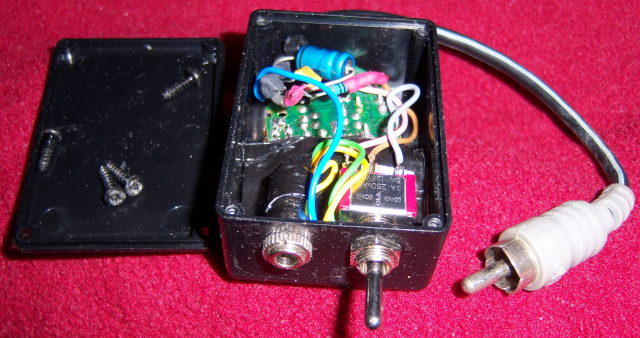 This simple fm radio receiver circuit consists of a regenerative rf stage, TR1, followed by a two of three-stage audio amplifier, TR2 to TR4. In some areas 3 stages of audio amplification may not be necessary, in which case TR3 and its associated components can be omitted and the free end of capacitor C5 connected to the collector of TR2.
Posted on Saturday, September 11, 2010 • Category: FM Radio / Receivers
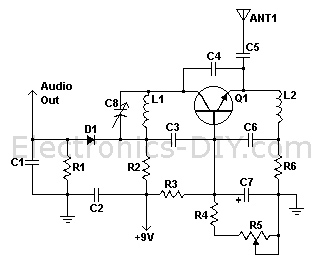 The communications between commercial aircraft and the ground can be interesting, amusing and sometimes even disturbing. However radios that receive the approximately 220MHz to 400MHz band commonly used for aircraft (both military and commercial) are not easily found. And scanners can be complicated, large and expensive. With an easy to build circuit such as this one, everyone can enjoy listening in on these conversations.
Posted on Wednesday, May 26, 2010 • Category: FM Radio / Receivers
 This handy cell phone detector, pocket-size mobile transmission detector or sniffer can sense the presence of an activated mobile cellphone from a distance of one and-a-half meters. So it can be used to prevent use of mobile phones in examination halls, confidential rooms, etc. It is also useful for detecting the use of mobile phone for spying and unauthorized video transmission.
Posted on Wednesday, May 26, 2010 • Category: FM Radio / Receivers
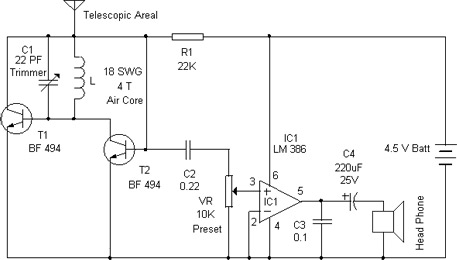 Perhaps this is one of the simplest and smallest FM Receiver that can receive the FM stations available locally. Its simple design makes it ideal for a pocket sized FM receiver. The output of the receiver drives a head phone.The circuit works off a small 4.5 volt battery or two 3.6 volt Lithium button cells.
Posted on Saturday, April 19, 2008 • Category: FM Radio / Receivers
 This a is complete FM radio receiver in a single chip. The board features a reset and scan button that tunes to the next radio station in a fraction of a second. Receiver offers excellent sensitivity and impressive loudness from such a small speaker. Just connect red (+) and black (-) leads to 2-5V voltage supply (or two to three AA battery cells), extend green antenna wire and you are ready to listen to your favorite FM radio stations.
Posted on Tuesday, April 8, 2008 • Category: FM Radio / Receivers
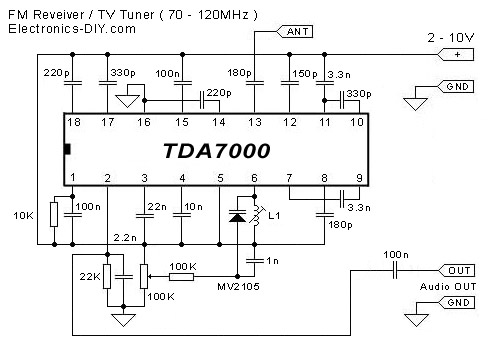 This simple one chip FM receiver / TV tuner will allow you to receive frequencies from 70 up to 120MHz. With this small receiver it is possible to pickup TV stations, entire 88 - 108MHz FM band, aircraft conversation and many other private transmissions. It is a perfect companion to any FM Transmitter especially if FM band in your area is very crowded. TDA7000 receiver offers very good sensitivity therefore it will even allow you to pickup weaker signals that cannot be heard on conventional FM receivers.
Posted on Thursday, April 3, 2008 • Category: FM Radio / Receivers
With the TDA 7000 you can build an FM radio with a minimum of components; most of them so easy to manage...like the ceramic capacitors that do not require polarization...and only two resistors. The components you will employ will be of small dimensions and low cost. Even the integrated circuit itself, the TDA 7000, is not of great cost.
Circuit-Zone.com © 2007-2026. All Rights Reserved.
|